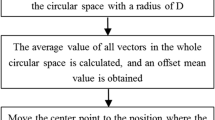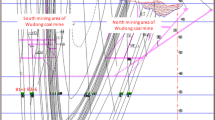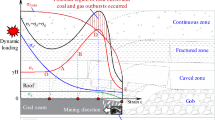Abstract
For this study, microseismic (MS) and electromagnetic radiation (EMR) monitoring systems were installed in a coal mine to monitor rock bursts. The MS system monitors coal or rock mass ruptures in the whole mine, whereas the EMR equipment monitors the coal or rock stress in a small area. By analysing the MS energy, number of MS events, and EMR intensity with respect to rock bursts, it has been shown that the energy and number of MS events present a “quiet period” 1–3 days before the rock burst. The data also show that the EMR intensity reaches a peak before the rock burst and this EMR intensity peak generally corresponds to the MS “quiet period”. There is a positive correlation between stress and EMR intensity. Buckling failure of coal or rock depends on the rheological properties and occurs after the peak stress in the high-stress concentration areas in deep mines. The MS “quiet period” before the rock burst is caused by the heterogeneity of the coal and rock structures, the transfer of high stress into internal areas, locked patches, and self-organized criticality near the stress peak. This study increases our understanding of coal and rock instability in deep mines. Combining MS and EMR to monitor rock burst could improve prediction accuracy.













Similar content being viewed by others
Abbreviations
- σ i :
-
Principal stress
- ɛ i :
-
Principal strain
- λ, G :
-
Lame constants
- E :
-
Young’s modulus
- v :
-
Poisson’s ratio
- σ c :
-
Uniaxial compressive strength
- m :
-
Distribution scale of the Weibull distribution
- ɛ 0 :
-
Shape parameter of the Weibull distribution
- ɛ :
-
Strain of the coal or rock micrograins
- φ(ɛ):
-
Failure probability
- N :
-
EMR pulses
- N 0 :
-
Total EMR pulses
- W 0 :
-
Energy per EMR pulse
- W :
-
Total EMR pulses energy
- W e :
-
EMR energy
- E m :
-
EMR intensity
- D :
-
Electric displacement
- V :
-
Coal or rock volume
- U :
-
Total potential energy
- U E :
-
Strain energy
- W L :
-
Potential energy
- U s :
-
Dissipative energy
- F 0 :
-
Initial force
- k :
-
Dynamic stiffness
- u 0 :
-
Displacement of the loading system
- u :
-
Displacement of the coal or rock mass
- f(u):
-
Constitutive curve of the coal or rock mass
- \(f^{\prime } \left( u \right)\) :
-
Tangent slope of f(u) − u
References
Altherr R, Henes-klaiber U, Hegner E, Satir M (1999) Plutonism in the Variscian Odenwald (Germany): from subduction to collision. Int J Earth Sci 88:422–443
Anderson TW (1962) Distribution of the two-sample Cramer-von Mises criterion for small equal samples. Ann Math Stat 34(3):1148–1159
Bahat D, Rabinovitch A, Frid V (2005) Tensile fracturing in rocks: tectonofractographic and electromagnetic radiation methods. Springer, Berlin, p 570
Chen ZJ, Wen XM (1983) Swelling rocks and stability of tunnels. Chin J Rock Mech Eng 2(1):1–10
Chen Y, Huang TF, Liu SR (2009) Rock physics. Press of University of Science and Technology of China, Hefei, pp 168–170
Dai ZY, Chen YW, Fu RS (2006) The study of precursory seismic quiescence. Prog Geophys 21(1):18–24
Dou LM, He XQ (2001) Bum** prevention and control theory and technology. China Mining University Press, Xuzhou, pp 5–10
Drossel B, Schwabl F (1992) Self-organized critical forest-fire model. Phys Rev Lett 69(11):1629–1632
Frid V (1997) Electromagnetic radiation method for rock and gas outburst forecast. J Appl Geophys 38(2):97–104
Gale WJ, Heasley KA, Iannacchione AT (2001) Rock damage characterisation from microseismic monitoring. In: Elsworth D, Tinucci JP, Heasley KA (eds) Rock mechanics in the national interest. Swets and Zeitlinger, Washington, pp 1313–1320
Ge MC (2005) Efficient mine microseismic monitoring. Int J Coal Geol 64(1–2):44–56
He MC, **e HP, Peng SP, Jiang YD (2005) Study on rock mechanics in deep mining engineering. Chin J Rock Mech Eng 24(16):2803–2813
Iannacchione AT, Bajpayee TS (2005) Forecasting roof falls with monitoring technologies—a look at the Moonee Colliery experience. In: 24th International conference on ground control mining, Morgantown, pp 44–51
Jiang YD, Zhao YX, Liu WG, Zhu J (2009) Investigation on the mechanism of coal bumps and relating experiments. Science Press, Bei**g, pp 12–15
Jiang YD, Pan YS, Jiang FX (2014) State of art review on mechanism and prevention of coal bumps in China. J China Coal Soc 39(2):205–213
Kaiser PK, Tannant DD, McCreath DR (1996) Canadian rockburst support handbook. Geomechanics Research Centre, Laurentian University, Sudbury
Kaiser PK, Vasak P, Suorineni FT, Thibodeau D (2005) New dimensions in seismic data interpretation with 3-D virtual reality visualization in burst-prone ground, Ra-Si M6. Perth, Australia, pp 33–47
Li XL (2014) Study on comprehensive warning of rock burst in Qianqiu Coal Mine. China University of mining and technology, Xuzhou, pp 9–20
Li XB, Li DY, Liu ZX, Zhao GY, Wang WH (2013) Determination of the minimum thickness of crown pillar for safe exploitation of a subsea gold mine based on numerical modeling. Int J Rock Mech Min Sci 57(1):42–56
Li XL, Li ZH, Wang EY (2016) Analysis of natural mineral earthquake and blast based on Hilbert–Huang transform (HHT). J Appl Geophys 128(5):79–86
Lichtenberger M (2006) Underground measurements of electromagnetic radiation related to stress-induced fractures in the Odenwald Mountains (Germany). Pure appl Geophys 163(8):1661–1677
Liu JP, Feng XT, Li YH, Xu SD, Sheng Y (2013) Studies on temporal and spatial variation of microseismic activities in a deep metal mine. Int J Rock Mech Min Sci 60(8):171–179
Liu J, Wang EY, Song DZ (2015) Effect of rock strength on failure mode and mechanical behavior of composite samples. Arab J Geosci 8(7):4527–4539
Lu CS, Ke FJ, Bai YL (1995) Computer simulation of evolution induced mutation. Sci China (Ser A) 25(1):54–60
Mei SR (1995) Research on earthquake precursor field physics models and precursor temporal distribution mechanism. Earthquake 17(3):273–282
National Bureau of Statistics of the People’s Republic of China. (http://www.gov.cn/gzdt/2011-02/28/content_1812697.htm)
Ogawa T, Oike K, Miura T (1985) Electromagnetic radiations from rocks. J Geophys Res 90:6245–6250
O’Keefe SG, Thiel DV, Davey NP (2000) Fracture induced electromagnetic emissions in the mining industry. Int J Appl Electromagn Mech 12:203–209
Ortlepp WD (2000) Observation of mining-induced faults in an intact rock mass at depth. Int J Rock Mech Min Sci 37(1):423–436
Pan YS, Li ZH, Zhang MT (2003) Distribution, type, mechanism and prevention of rockbrust in China. Chin J Rock Mech Eng 22(11):1844–1851
Peng SS (2015) Topical areas of research needs in ground control-A state of the art review on coal mine ground control. Int J Min Sci Technol 25(1):1–6
Qian MG, Shi PW (2003) Ground Pressure and Strata Control. China University of Mining and Technology Press, Xuzhou, pp 78–83
Qin SQ, Xu XW, Hu P (2010) Brittle failure mechanism of multiple locked patches in a seismogenic fault system and exploration on a new way for earthquake prediction. Chin J Geophys 53(4):1001–1014
Rabinovitch A, Bahat D, Frid V (2002) Similarity and dissimilarity of electromagnetic radiation from carbonate rocks under compression, drilling and blasting. Int J Rock Mech Min Sci 39(1):125–129
Sa ZY (2003) Rheology of coal and destroy abnormal electromagnetic radiation effects and discrimination of technology. China University of Mining and Technology, Xuzhou, pp 51–56
Sa ZY, He XQ, Wang EY (2005) An experimental study of the EME memory effect during the deformation and fracture of coal or rock. Chin J Geophys 48(2):379–385
Sivakumar C, Srinivasan C, Willy YA, Murthy C (2008) Real time microseismic monitoring to study geomechanics of underground structures. In: Proceedings of the 12th international conference of international association for computer methods and advances in geomechanics (IACMAG), Goa, India, 1–6, October, pp 1972–1979
Song DZ, Wang EY, Li ZH (2015) Energy dissipation of coal and rock during damage and failure process based on EMR. Int J Min Sci Technol 25(5):787–796
Srinivasan C, Arora SK, Benady S (1999) Precursory monitoring of impending rock bursts in Kolar gold mines from microseismic emissions at deeper levels. Int J Rock Mech Min Sci 36:941–948
Stacey TR (2011) Support of excavations subjected to dynamic (rockburst) loading. In: Proceedings of the 12th international congress of the international society of rock mechanics, pp 137–145
Sun XH (2009) Rockburst prevention and control technology under complex mining conditions. Metallurgical Industry Press, Bei**g
Tang CA (1993) Catastrophe in the fracture process of rocks. China Coal Industrial Publishing House, Bei**g
Urbancic TI, Trifu CI (2000) Recent advances in seismic monitoring technology at Canadian mines. J Appl Geophys 45(4):225–237
Wang EY, He XQ, Dou LM, Zhou SN, Nie BS, Liu ZT (2005) Electromagnetic radiation characteristics of coal and rocks during excavation in coal mine and their application. Chin J Geophys 48(1):216–221
Wang EY, He XQ, Li ZH, Zhao EL (2009) Electromagnetic radiation technology and application of coal or rock. Science Press, Bei**g
Wang EY, He XQ, Wei JP, Nie BS, Song DZ (2011a) Electromagnetic emission graded warning model and its applications against coal rock dynamic collapses. Int J Rock Mech Min Sci 48(4):556–564
Wang EY, He XQ, Liu XF, Li ZH, Wang C, **ao D (2011b) A non-contact mine pressure evaluation method by electromagnetic radiation. J Appl Geophys 75(2):338–344
Wang EY, Jia HL, Song DZ, Li N, Qian WH (2014) Use of ultra-low-frequency electromagnetic emission to monitor stress and failure in coal mines. Int J Rock Mech Min Sci 70:16–25
**a MF, Han WS, Ke FJ (1995) Statistics mesoscopic damage mechanics and damage evolution induced catastrophe. Adv Mech 25(1):1–40
**ao HF, He XQ, Feng T (2004) Research on coupling laws between EME and stress fields during deformation and fracture of coal and rock in uniaxial compression. Chin J Rock Mech Eng 23(23):3948–3953
**e HP (1996) Fractal-Introduction to rock mechanics. Science Press, Bei**g
Xu NW, Dai F, Liang ZZ, Zhou Z, Sha C, Tang CA (2014) The dynamic evaluation of rock slope stability considering the effects of microseismic damage. Rock Mech Rock Eng 47(2):621–642
Yamada I, Masuda K, Mizutani H (1989) Electromagnetic and acoustic emission associated with rock fracture. Phys Earth Planet Inter 57(1):157–168
Zhang JJ, Fu BJ (2008) Rockburst and its criteria and control. Chin J Rock Mech Eng 27(10):2034–2042
Acknowledgments
This work is supported by the National Natural Science Foundation of China (51574231), Excellent Innovation Team of China University of Mining and Technology (2014ZY001), Fundamental Research Funds for the Central Universities (2015XKMS005), and A Project Funded by the Priority Academic Program Development of Jiangsu Higher Education Institutions (PAPD). We thank anonymous reviewers for their comments and suggestions to improve the manuscript.
Author information
Authors and Affiliations
Corresponding author
Rights and permissions
About this article
Cite this article
Li, X., Wang, E., Li, Z. et al. Rock Burst Monitoring by Integrated Microseismic and Electromagnetic Radiation Methods. Rock Mech Rock Eng 49, 4393–4406 (2016). https://doi.org/10.1007/s00603-016-1037-6
Received:
Accepted:
Published:
Issue Date:
DOI: https://doi.org/10.1007/s00603-016-1037-6




